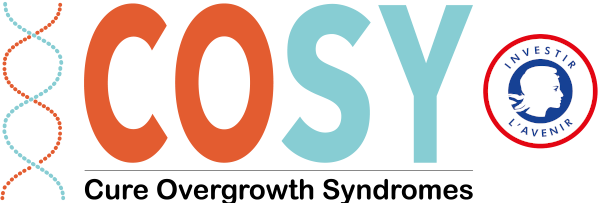Overgrowth syndromes are defined as a group of rare genetic syndromes characterized by malformations and tissue proliferation caused by somatic mutations affecting different mTOR genes of which the most well-known is PIK3CA.
Patients with these syndromes may have gain-of-function mutations (PIK3CA, AKT1, AKT2 or AKT3, mTOR, etc.) or loss-of-function mutations (PTEN, TSC1, TSC2, etc.). Either way, these lead to excessive activation of the mTOR pathway, a signaling pathway that plays a major role in controlling cell growth and proliferation. These mutations usually occur during embryonic development, in other words, after fertilization (mosaic), and can affect any type of tissue.
Clinical presentation
The clinical presentation at birth is extremely variable depending not only on when the mutation occurred (e.g. at early or late stage of the embryological development) but also on the type of tissue affected (vessels, muscle, fat, bones, nerve cells, etc.). The excessive activation of the mTOR pathway leads to excessive proliferation (hyperplasia) as well as an increase in the size of cells (hypertrophy) which are both responsible for complex and anarchic malformations that deform the body and limbs. The disease is present since the moment of birth, it can even sometimes be identified during the antenatal period and will progress with age. Malformations are not stable and increase in volume throughout the patients’ life. The rate of growth is extremely variable from one patient to another.
Clinical diagnosis
In addition to complex clinical diagnosis, the identification of the mutated gene can be extremely difficult. The detection of the mutation requires a biopsy of the affected tissue (mosaic) and current sequencing methods, namely Next-Generation Sequencing – NGS since the mosaic rate can be as low as 1%. For this reason, only a few medical centers can provide a precise diagnosis. The broad clinical presentation and the technical problems in identifying the mutation make the diagnosis extremely difficult for physicians.
It is important to recall that in several cases (approximately 20% in our experience), no genetic abnormalities are identified among the genes known to cause overgrowth syndromes.
Clinical complications
These syndromes may include several complications such as functional impairment (e.g. in walking or in the activities of daily living) pain, recurrent superficial infections (erysipelas), phlebitis with or without pulmonary embolism, bleeding, and/or organ dysfunction. These conditions are responsible for substantial morbidity and premature mortality. Currently, there is no specific treatment available for these pathologies and only symptomatic treatments are proposed (analgesics, anticoagulation, radiological embolization or surgery). Most of the time a multidisciplinary therapeutic approach is required. Unfortunately, these patients often undergo numerous mutilating surgical procedures (orthopedic, visceral, maxillofacial, etc.).
Furthermore, overgrowth syndromes are frequently associated with crippling disabilities resulting in deleterious social consequences characterized by a high rate of school drop out for children and desocialization.
Among patients with overgrowth syndromes, there is a group characterized by the presence of gain-of-function mutation of the PIK3CA gene. These patients are classed under the general term PIK3CA-related overgrowth syndrome (PROS) which encompasses a group of syndromes with various phenotypes, including (but not limited to):
- CLOVES Syndrome(Congenital Lipomatous Overgrowth, Vascular Malformations, and Epidermal Nevi)
- Macrocephaly-capillary malformation (M-CM)
- HemiHyperplasia-Multiple Lipomatosis syndrome (HHML)
- FibroAdipose Overgrowth (FAO)
- Hemimegalencephaly or Unilateral Megalencephaly (HME)
- Facial Infiltrating Lipomatosis (FIL)
- Klippel-Trenaunay Syndrome (KTS)
Importantly, these genetic mutations are commonly found in cancer and the reposition and/or repurpose drugs primarily developed for oncology can be very promising for patients with these rare syndromes. Some of these molecules, when used at low levels, show therapeutic effects that have yet to be confirmed.
From Research to Discovery of Treatment
We recently created the first mouse model of PROS syndrome, identified BYL719 (alpelisib, a PIK3CA inhibitor developed in oncology), and demonstrated its effectiveness in our PROS mouse model. Based on these results, we obtained the authorization of the French National Agency for the Safety of Medicines and Health Products to treat 19 patients with a severe form of the disease. The results were remarkable with an improvement in numerous parameters (bleeding, pain, fatigue, etc.) but also morphological changes with a rapid reduction in the size and volume of tumors. This molecule is well tolerated with little or no side effects observed thus far.
After the release of the scientific paper, we received a certain number of patients with PROS and severe disabilities, to whom we were authorized to give the BYL719 under a compassionate use program.
Hospital Facility
So far, more than 3500 patients across the globe have reached us including 480 French patients. Most of the patients were affected by overgrowth but without a molecular diagnosis. To face this huge demand, we organized our clinical department at Necker-Enfants Malades hospital in order to offer the best services as possible. In a single day, patients have access to all physicians, surgeons, biopsy, DNA storage, and imaging. Patient flow is always very high with new daily requests.
